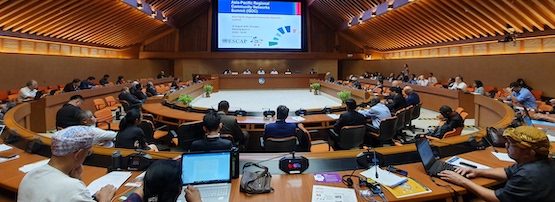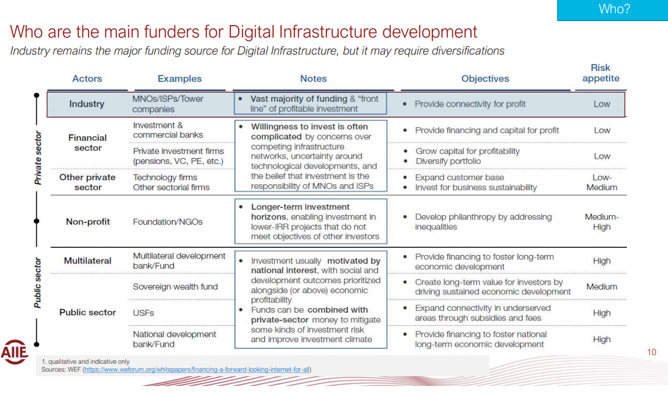
Internet user growth is slowing across the world, as noted this year by the UN Broadband Commission’s 2019 State of Broadband report, most acutely in the Asia Pacific region.
The latest figures, released by the ITU in November, show that Internet user growth in the region has fallen from 15% growth in 2017 to 5.7% in 2019, while total Internet adoption for the Asia Pacific region remains below half of the total population (48.4%). To overcome this, the region requires innovative funding solutions that encourage accelerated progress towards universal Internet access and adoption in the Asia Pacific region.
The United Nations Economic and Social Commission for Asia and the Pacific (ESCAP)’s Third Session of the Asia-Pacific Information Superhighway (AP-IS) Steering Committee and WSIS Regional Review showcased a range of these financing options for connectivity, from early stage small-grant support highlighted by the APNIC Foundation’s ISIF Asia program, Connectivity Capital’s expansion debt capital for small but growing ISPs, as well as development finance investment by the World Bank, Asian Development Bank (ADB) and Asian Infrastructure Investment Bank (AIIB).
While the world celebrates a number of Internet related milestones this year (50 years since the first data packets were transmitted across ARPANET, 30 years since the beginning of the World Wide Web, and the first year when more than 50% of the globe is online), a number of reports have noted that the speed and success that the global Internet community has achieved in connecting half of humanity to the Internet so quickly will be hard to replicate in connecting the remaining 46.4% of the world’s population.
GSMA, the association of mobile network operators, has said that mobile operators struggle to deploy infrastructure to communities in rural and remote settings due to disincentives to investment as compared to investment in high population density, higher income urban areas, stating that:
“operators often struggle to deploy mobile broadband in rural and remote areas, as costs can be prohibitive, revenue lower and logistics complex. The average revenue of a rural cell site can be 10 times lower than one in an urban setting, while the cost of building and maintaining network infrastructure in a rural area is often double.”
GSMA Connected Society — Closing the Coverage Gap: How Innovation Can Drive Rural Connectivity (emphasis added)
As a result of poor commercial incentives for private investment to provide universal coverage, the role of public investment in extending access and connectivity for the remaining unconnected population becomes even more apparent. For example, the World Bank and UN Broadband Commission recently launched an analysis assessing that USD 109 billion is needed to achieve universal, affordable access to broadband Internet in Africa by 2030.
While a similar analysis has yet to be done in the Asia Pacific region, the ESCAP program on the AP-IS is focused on increasing infrastructure, adoption and financing of initiatives to increase Internet usage across the region.
Investment and development need to come in many forms, not just finance
At the AP-IS meeting, different funding organizations shared their investment focus, demonstrating the range of financing available from early stage small-grant support to expansion debt capital for small but growing Internet service providers, to large scale cross-border sovereign debt financing (See Figure 1 below).

Focusing on early stage grant support, the APNIC Foundation highlighted its ISIF Asia program. Since 2008, the program and has supported 103 initiatives (including the 2019 winners, announced at the ESCAP event), with funding coming from APNIC, IDRC, Sida, Dot Asia Organization, ICANN and APIA.
Over USD 3.5 million has been allocated across 24 economies and the program’s efforts have been recognized twice by the ITU as World Summit on the Information Society (WSIS) champions in 2018 and 2019. The program has provided financial support through small, non-refundable grants, scale-up grants, one-off awards, as well as mentoring and networking opportunities to organizations addressing local access challenges through network deployments across a variety of technologies. These include improvements to existing networks to assist as they scale-up; as well as research into new solutions, including power management.
With a focus on funding small but growing ISPs through debt capital, Connectivity Capital highlighted the significant gap in affordable access in emerging economies as a result of both poor coverage and prohibitive prices from mobile networks, and how nascent fibre and Wi-Fi ecosystems are supporting the growth of wireless Internet service providers. The firm focuses on debt financing for small and expanding connectivity providers with loan sizes between USD 200,000 and USD 2,000,000. It particularly targets entities that are too small to be able to benefit from concessionary financing from the traditional development finance institutions.
Read: Helping ISPs Grow
For the larger development finance institutions covering the region, the World Bank presented their past and current investments, some alongside the ADB, particularly in cross-border and undersea fibre optic investments, ranging from USD 6.8m upwards to USD 47.5m.
The AIIB noted that conventional multilateral financing for telecommunications has been comparatively small compared to other sectors. In fact, a recent report by the Alliance for Affordable Internet demonstrates that only about 1% of multilateral development financing (or USD 5bn between 2013-2016) has gone to Internet connectivity investments. Only 39% of that has gone into infrastructure investment, with average investments of USD 30m.
However, only larger telecommunications entities have the absorptive capacity to be able to effectively receive and efficiently use financing in the range of USD 30m or so. Many smaller service providers, community networks, and other local operators need financing in smaller, more manageable sizes in addition to technical assistance to develop capacity for managing growth and larger investment. The AIIB presentation noted the need for a range of funding options across the public and private sectors in order to support the sector (See Figure 2 below).

The different financing organizations at the AP-IS meeting demonstrated their support for the overall sector and the goals of the ESCAP initiative.
Encouraging more investors, from concessional grant financing to large project investment, will only further help to encourage accelerated progress towards universal Internet access and adoption in the Asia Pacific region.
John Garrity is an economist, policy advisor and program manager focusing on digital inclusion through pro-poor information and communications technology (ICT) to foster universal Internet access and adoption.
The views expressed by the authors of this blog are their own and do not necessarily reflect the views of APNIC. Please note a Code of Conduct applies to this blog.
